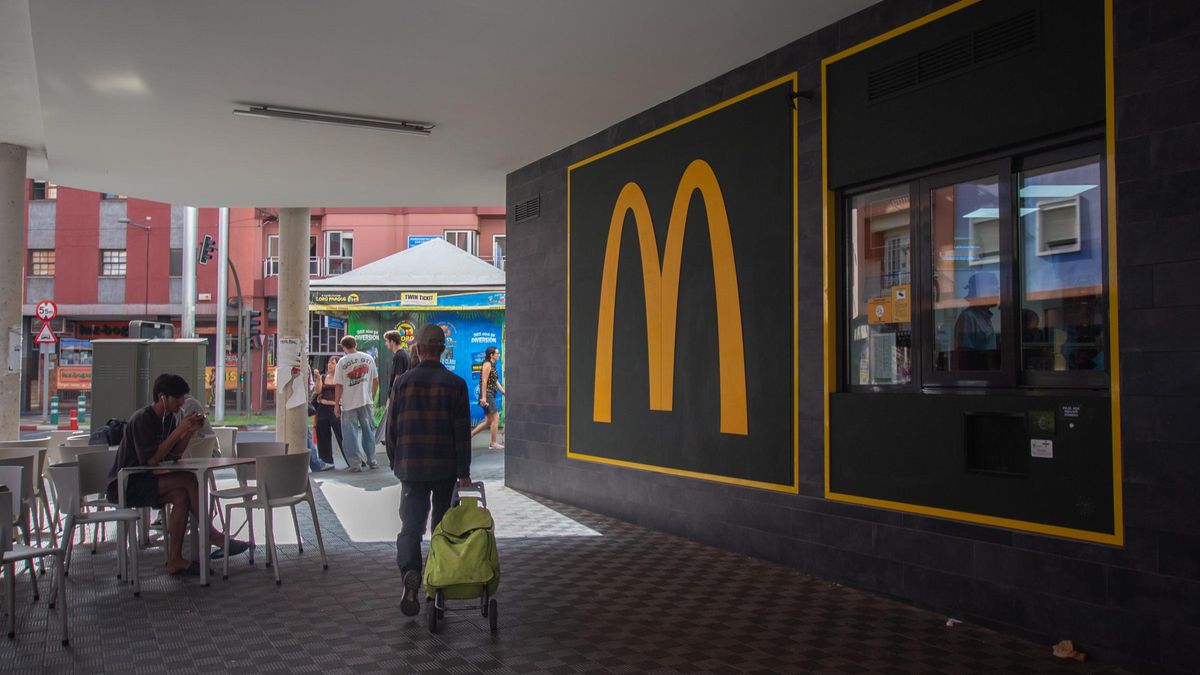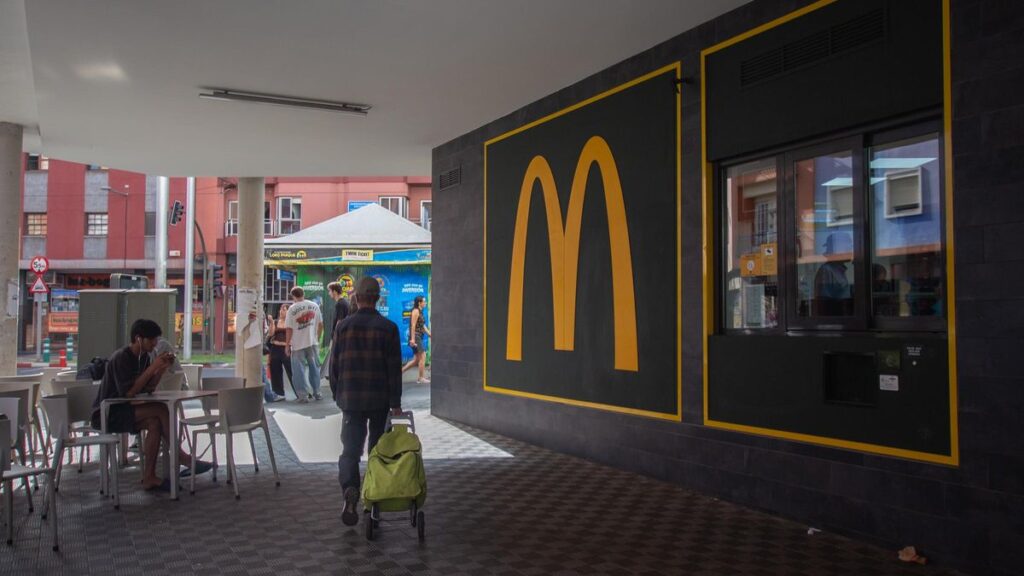The yellow ‘M’ on the historic avenue
A giant yellow ‘M’ presides over the main avenue in the center of La Laguna, Tenerife. Positioned next to a small appliance store and at the gates of the historic quarter of this UNESCO World Heritage city, the international chain McDonald’s opened its 20th location on the island just over a year ago. Across the sidewalk, Natalia Meléndez is busy preparing hot dogs. It’s 6:00 PM, and although she only opened half an hour ago, a steady stream of customers flows into her business.
A daily struggle for survival
Natalia is one of the local merchants who has managed to survive the proliferation of franchises in La Laguna, a phenomenon that has been gradually squeezing out long-established family businesses. Between customers, the owner explains that Perritos La Concepción has two locations and 34 years of history. “We’ll celebrate 35 years in February,” she says proudly. “It’s a daily struggle to maintain something that’s your own. To always keep it nice, clean, and maintain the same quality as when we started,” she details. Natalia lives in La Laguna and has witnessed how local businesses have had to fight to preserve their space amid the arrival of large corporations.
The homogenization of tourist experience
“It’s a shame, but if people go there… The demand exists,” she says with disappointment. “People now prefer to serve themselves and pay for products that are more expensive, even though neither the quality nor the personal service matches what you find in small local businesses,” she emphasizes. For historian and sociologist Álvaro Santana, the answer is clear: “It’s the failure of current mass tourism, which aims to visit places unrelated to its own culture in a way that reproduces the lifestyle of the place they come from.”
“Franchises are a cornerstone of that homogenization of the tourist experience that globalization has brought over the last 30 years,” adds Santana, who is also a professor at Whitman College and an instructor at Harvard Summer School.
Preserving tradition through word of mouth
Despite these new consumption trends, Natalia Meléndez has managed to keep her regular customers while attracting new generations. “It’s word of mouth. Grandparents come with their grandchildren, those who came with their parents now come with their own children… It’s a chain, and it’s beautiful,” she shares during one of the few moments when her shop is empty.
A threat to local identity
This phenomenon, which isn’t unique to La Laguna and has affected various cities across Spain and Europe, “directly threatens” the identity of the places where it takes root. “The people who make a city, who give it its identity, aren’t the tourists. They’re the people who live on those streets, in those squares of the historic city,” argues historian Álvaro Santana.
In La Laguna, you can eat a hamburger for almost 20 euros, drink bubble tea, or buy a phone case in any color at a franchise. However, among multinational clothing chains and souvenir shops, it’s becoming increasingly difficult to buy a lightbulb, a toy, or “a can of tuna.”
The changing social fabric
“Franchises, bars, and restaurants have made living in the historic center an unpleasant experience. You go out into the street and find people on terraces, but that civic fabric of running into your neighbor at the hardware store or haberdashery isn’t being created,” points out the sociologist.
Elena Pérez, professor and researcher in Archaeological Heritage Management and Tourism at the European University of the Canary Islands (UEC), agrees with this assessment. “What’s being imposed is an economic model based on individual profitability and mass tourism, which transforms urban ways of life and weakens collective memory,” she explains.
Tourism pressure and authenticity loss
In a context of public discontent in the islands over the tourism model, the expansion of franchises “adds more pressure and threatens the authenticity of historic cities.” According to Elena Pérez, the cost of not limiting tourism in historic centers isn’t just economic, but also identity-related: “We lose authenticity, urban memory, and the heritage significance that distinguishes us.”
“This year we’ve seen it clearly in the Canary Islands, with the collapse of visits to El Teide as a symbol of tourism pressure, or the transformations in restaurant menus and prices in the center of La Laguna and the evident increase of tourists on its streets,” she illustrates.
A family tradition of local commerce
Ernesto Rapp is an optician and owner of a business with more than 35 years of history located near the emblematic Plaza de La Concepción. His family has always been dedicated to local commerce in La Laguna. His grandparents founded the sweet shop La Princesa, his father ran a grocery store, and his maternal family owns a jewelry store.
In the area where he maintains Óptica Rapp, there used to be a children’s clothing store, an appliance store, a small hairdresser, and a curtain shop. Now, “family businesses have been replaced by taverns, bars, and cafeterias,” he says.
The disappearance of residential life
“Before, many families lived here. Now there might be six at most in the entire square. Properties have been vacated or converted into vacation rentals,” points out merchant Ernesto Rapp.
“Businesses that provide services are disappearing, they’re closing. Who can pay the rents? The franchises that have stores throughout Europe and that, if they do poorly, have 300 other businesses to support them,” he asserts.
The unsustainable cycle
Large chains drive up commercial property prices and cause a rise in rents. “A cycle is created in which tourism pressure, global capital, and real estate speculation feed off each other, at the cost of a model that isn’t sustainable socially or territorially in the Canary Islands,” adds researcher Elena Pérez.
In recent years, Ernesto has received offers from large eyewear chains to join them. “When those proposals came to me, my business was already quite established, with a large client portfolio, so I wasn’t interested,” he recalls.
Choosing independence over franchise
“Many opticians have partnered with chains, and I wanted to remain independent. It has cost me a lot to get here, and I understood that accepting the offer would mean dissolving into a sea of franchises. I believe we made the right decision,” he explains.
World Heritage status and its challenges
San Cristóbal de La Laguna was declared a UNESCO World Heritage Site in 1999. “The historical and cultural appeal fosters a flow of visitors and turns the center into a highly coveted space for franchises,” indicates the UEC professor.
The transformation of these enclaves questions, according to the expert, “the very meaning of the World Heritage declaration”: “It jeopardizes the authenticity that was intended to be protected.”
The tourist perception problem
“People who visit the center perceive the destination as a setting where they expect to find services and easy access to places in a fast, intense, and short-duration manner. This determines mobility, crowding in certain city areas, and the increased cost of spaces,” continues the heritage expert.
In addition to mass tourism and rental prices, there’s the lack of generational succession. “It’s a real problem in historic centers. The new generations often don’t continue with family businesses,” adds Pérez.
Criticism of urban planning
These elements facilitate the entry of external companies, “especially in a context of real estate pressure and gentrification.” For Álvaro Santana, the Special Protection Plan (PEP) for the Historic Center approved in 2005 “has destroyed a great deal of heritage.”
“That plan liberalized the uses of commercial premises and the ground floors of historic buildings. Not only do local businesses have to compete with high rents on upper floors, but so do residents and families living on ground floors,” maintains the expert.
Municipal response and future plans
The City Council of La Laguna responded to this newspaper that the PEP approved in 2005 “establishes different zoning sectors with permitted and complementary land uses, restricting tertiary uses in two of the three sectors: the transition zone and the intensive housing zone.”
For restaurant uses, this document “sets a maximum surface area of between 400 and 800 square meters and a maximum capacity of between 120 and 250 people.” Likewise, the municipal corporation explains that this plan imposes “restrictive criteria to guarantee the conservation and maintenance of cataloged buildings or specific regulation of signage throughout the area.”
Even so, the City Council plans to tender the update of the PEP at the end of 2025, which will include contributions from all stakeholders to achieve a “consensual and effective legal regulation for historical, traditional, and local commerce in the historic complex.”
Potential solutions
“Although change and social and cultural transformations occur and we cannot go against them, we can manage them, make them less abrupt, pay attention to the speed at which they happen, and know what undermines the comprehensive quality of life of communities,” proposes Elena Pérez.
For the professor, supporting small businesses in modernization and digital transformation processes is key so they can compete better without losing their identity. “The combination of institutional support, innovation, and technological adaptation can be crucial for the survival of local businesses,” she advocates.
The role of education and regulation
The researcher adds education as a fundamental element, both for the local population and tourists: “Those of us who live in La Laguna end up doing the same as tourists, shopping and eating in the same places, transforming our habits, traditions, and customs.”
For his part, Álvaro Santana argues that the first thing to do is “comply with the National and Canarian Heritage Laws, which prohibit renting out the ground floors of historic buildings.” “Harmful commerce must be removed from the ground floors of a historic center,” he proposes.
The historian insists that tools must be implemented to allow La Laguna to be “a city of citizens” and to regulate the percentage of franchises that can be installed in a single block of the historic center. “What’s needed is the courage and creativity to regulate the use of residential and commercial space within a historic center,” he adds.
Legal limitations and economic freedom
Along these lines, the City Council emphasizes that if the activity to be developed complies with regulations and fits within the planned urban and sectoral limits, “the type of company that decides to establish itself or the management modality chosen is not grounds for denial.”
“To be able to make an administrative limitation on the installation of franchises and establish limits to business freedom, it’s necessary to justify that these restrictions on access to an economic activity are motivated by compelling reasons of general interest, as well as having considered other less restrictive alternatives,” they add.
The City Council insists that prohibiting franchise activity per se would mean “incurring compensable assumptions and acting contrary to law.”
A city for passers-by
For Ernesto Rapp, the center of La Laguna is already designed for “people passing through.” “It’s becoming a large leisure center. A kind of stage set where people go for a stroll. It’s very pretty and has plenty of visitors, but truthfully, I preferred how it was before,” he concludes.


